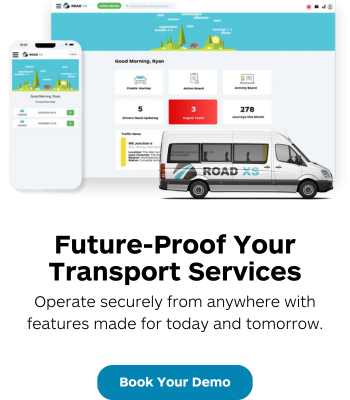In the fast-evolving world of transport services, where efficiency and scalability are critical, managing operations with paper and spreadsheets is increasingly inadequate.
As passenger numbers grow and the demand for more reliable and flexible services rises, the limitations of traditional methods become glaringly obvious.
This article explores why paper-based systems and spreadsheets fail in today’s dynamic transport environment and how cloud-based transport management systems (TMS) like Road XS offer a superior, cost-effective alternative.
The Inefficiencies of Paper and Spreadsheet-Based Systems
Paper-based systems and spreadsheets have long been the go-to tools for managing transport services. However, they come with several inherent flaws that become more pronounced as the scale and complexity of operations increase.
- Manual Data Entry and Errors: Paper and spreadsheets require manual data entry, which is time-consuming and prone to human error. According to a study published in the Journal of Business Logistics, manual data entry has an error rate of 1% to 3%. Transport management can lead to significant inaccuracies in scheduling, route planning, and financial reporting, ultimately affecting service reliability and customer satisfaction.
- Limited Scalability: As transport services expand, the amount of data that needs to be managed grows exponentially. Paper records become unmanageable, and while somewhat more flexible, spreadsheets often struggle to handle large datasets efficiently. The Harvard Business Review highlights that businesses relying on spreadsheets frequently encounter issues such as slow processing times and difficulty collaborating across teams, leading to bottlenecks in operations.
- Poor Real-Time Visibility: Modern transport services require real-time visibility into operations to respond quickly to changes and unexpected challenges. Paper records are static; even spreadsheets require constant manual updates to reflect real-time data. This lack of immediate insight can result in delays, missed opportunities, and a failure to meet customer expectations.
- Difficulty in Compliance and Reporting: Compliance with regulations and reporting requirements is crucial in the transport sector. Managing these tasks with paper or spreadsheets can be cumbersome, increasing the risk of non-compliance due to overlooked details or delays in generating reports. According to a report by PwC, companies that rely on outdated management systems face higher risks of compliance failures, which can lead to costly fines and damage to reputation.
The Advantages of Cloud-Based Transport Management Systems
Cloud-based Transport Management Systems (TMS) address these shortcomings by offering a comprehensive, integrated solution that automates many tasks traditionally handled by paper and spreadsheets.
Here’s why cloud-based systems are the future of transport management:
- Automation and Efficiency: Cloud-based TMS automate routine tasks such as scheduling, route optimisation, and data entry. This reduces the likelihood of human error and frees staff to focus on higher-value activities. For instance, a study by Gartner found that organizations using cloud-based systems saw a 30% reduction in operational costs due to automation.
- Scalability: One of the most significant advantages of cloud-based systems is their scalability. These platforms can easily handle large volumes of data and support expanding services without requiring significant additional investment in IT infrastructure. This makes them ideal for transport providers looking to grow their operations efficiently.
- Real-Time Data and Analytics: Cloud-based TMS provide real-time visibility into all aspects of transport operations, from vehicle tracking to passenger volumes. This enables transport managers to make informed decisions quickly, improving service reliability and customer satisfaction; according to research by McKinsey & Company, companies that leverage real-time data analytics experience a 15% increase in operational efficiency.
- Improved Compliance and Reporting: Cloud-based systems simplify compliance management by automatically tracking regulatory requirements and generating reports. This reduces non-compliance risk and ensures transport providers can quickly meet their reporting obligations. A Deloitte study notes that companies using automated compliance tools report 25% fewer compliance issues than those relying on manual processes.
- Cost-Effectiveness: While transitioning to a cloud-based TMS may require an initial investment, the long-term cost savings are substantial. By eliminating the need for extensive manual work, reducing errors, and improving operational efficiency, cloud-based systems often pay for themselves within a few years. These systems are typically subscribed, allowing transport providers to avoid the high upfront costs associated with traditional software or hardware investments.
Meeting the Growing Demand
As the number of passengers and the complexity of transport networks continue to grow, the demand for more sophisticated management tools will only increase. Cloud-based TMS not only help meet this demand by offering scalable solutions that can handle large datasets and complex operations but also support a better customer experience by enabling faster, more reliable services.
For example, the demand for patient transport services in the UK has significantly risen from 2010 to 2024, driven primarily by demographic changes and the increasing complexity of healthcare needs.
The most notable trend is within Non-Emergency Patient Transport Services (NEPTS), often provided by community transport providers. These services cater to patients who require transportation to medical appointments but do not need emergency ambulance services.
Between 2010 and 2024, the UK’s population aged 65 and over grew by approximately 24%, reflecting the broader ageing trend.
This demographic shift has been a critical factor in the rising demand for patient transport, as older adults are more likely to require frequent medical appointments and have mobility issues that necessitate specialized transport services.
Hospital admissions have also surged during this period, increasing the need for patient transport. The average daily number of hospital admissions rose by about 20%, while emergency admissions via A&E increased by over 40%. This escalation has intensified the pressure on NEPTS to provide timely and efficient transportation, particularly for elderly and vulnerable patients.
Since 2021, the NHS has enhanced its data collection and reporting on NEPTS to manage this growing demand. The aim is to ensure that these services remain responsive and equitable across different regions while also being sustainable in the face of increasing demand.
The data trends from 2010 to 2024 underline the necessity of modernising patient transport management systems and community transport booking software and systems. With their ability to handle large datasets and provide real-time operational insights, cloud-based solutions are crucial for meeting the escalating demand and ensuring the continuous provision of high-quality transport services to patients across the UK.
The Road Ahead
Road XS is revolutionising community transport and non-emergency patient transport services with its cutting-edge, scalable platform that integrates seamlessly into community infrastructures.
Unlike traditional systems bogged down by manual processes and outdated technology, Road XS uses the latest cloud-based solutions to deliver real-time data and automation across all transport operations. This ensures the efficiency and accuracy of every journey and the scalability to meet growing demands without compromising service quality.
One of the standout features of Road XS is its intuitive interface, which allows for easy scheduling, route optimisation, and instant communication between drivers, passengers, and coordinators. This interconnectedness enhances the overall user experience by minimising waiting times, reducing operational costs, and improving the reliability of transport services.
As patient numbers increase, the platform’s ability to scale effortlessly ensures that communities can continue to provide timely and essential transport services without disruption.
Road XS can integrate and extend beyond the transport network, connecting seamlessly with healthcare providers, local councils, and other community services.
This holistic approach strengthens community ties and supports the broader goal of delivering equitable and accessible healthcare. In essence, Road XS is not just a transport management tool; it’s a catalyst for community-driven healthcare innovation, ensuring that every patient receives the care and support they need exactly when needed.
Conclusion
The transport industry is at a crossroads. While paper-based systems and spreadsheets may have sufficed in the past, they are no longer viable in an era that demands efficiency, scalability, and real-time decision-making. Cloud-based transport management systems offer a powerful, cost-effective alternative that meets these demands and provides a platform for future growth and innovation.
For transport providers looking to stay competitive and serve their communities more effectively, moving to cloud-based systems is not just a technological upgrade but a strategic imperative. The future of transport management lies in the cloud, where efficiency, scalability, and customer satisfaction converge to drive success.


